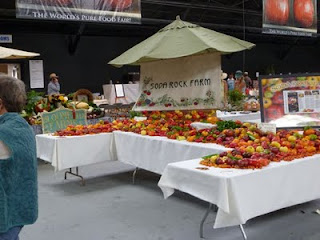For the last three days, the fairgrounds in Santa Rosa, CA have been Disneyland for heirloom vegetable heads. The National Heirloom Exposition and Pure Food Fair attracted thousands of spectators and gardeners, most of whom had the same goofy, wide-eyed, jaw-dropped look on their faces when they walked into the Exhibit Hall and saw Squash Mountain, built by Mac Condill of the Great Pumpkin Patch in Illinois.
Exposition goers were greeted at the main entrance by a huge, ornate pumpkin maze.
The Heirloom Exposition had it all: 250 like-minded vendors, including seed companies, tool companies, organic nurseries; 70 speakers; workshops galore on seed collecting, storing and sharing; movies about the food industry, including "Vanishing of the Bees" and "Food Fight"; food tasting; poultry and farm animal exhibits; bee exhibits; and the largest display of heirloom vegetables in the world: over 2,000 varieties from all over the country!
This event attracted a large number of teenagers, young adults and young families.
This tomato, Pink Berkeley Tie Dye, took first place honors at the recent Kendall-Jackson Tomato Festival.
Apple varieties more than 100 years old, courtesy of the California Rare Fruit Growers.
Note to self: plant this next year. Trevor's Golden Beam was my favorite at the tomato tasting on Thursday. More sweet than acidic, but still had full tomato flavor.
A red meat watermelon RADISH?!?
These are the hands of master chef Ray Duey. His freestyle carving creations took first prize. These are amazing melons!
No shortage of tomatoes here!
Tierra Madre Farm of Santa Cruz County, growers of heirloom fruit trees, demonstrates bud grafting.
Live bluegrass music, indoors and outdoors
This was the first year for the Heirloom Exposition. Organized by The Petaluma Seed Bank and their parent company, Baker Creek Seeds, this was a not-for-profit event, with proceeds donated to special projects, such as school gardens. If they return next year, make it a point to attend.





























